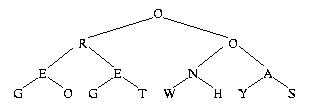COSC 270: Artificial Intelligence
Project 1
Spring 2015
Due: Thu, Jan 29 @ 11:59 P.M.
4 points
- Write a function that uses the do form to find the minimum
and maximum values in a list of numbers. The function should return
these two values in a list. Do not use the min and max
functions in your implementation.
- Same problem as above, but use recursion.
- Same problem as above, but use apply,
min, and max.
- Encode the following tree as a list assigned to a globally
declared variable. Write the Lisp functions preorder and
postorder that return as a list the pre-order and post-order
traversals of the tree passed in as the argument, respectively.

For example,
> (preorder *tree*)
(O R E G O ... )
- Encode the following graph using property lists. Write a Lisp
function that, when given a start and an end node, uses depth-first
search to return a path between them.

For example,
>(dfs 'a 'g)
(A C F E G)
>(dfs 'f 'g)
(F E G)
>(dfs 'e 'c)
NIL
- Develop a representation for a tic-tac-toe board. Write a
function named successors that, when given a board
configuration as its argument, returns a list containing all
of the next possible moves.
- Tanimoto defined a heuristic evaluation function for tic-tac-toe
boards as
f = 100A + 10B + C - (100D + 10E + F),
where
- A is the number of lines with 3 X's,
- B is the number of unblocked lines w/ 2 X's,
- C is the number of unblocked lines with 1 X,
- D is the number of lines with 3 O's,
- E is the number of unblocked lines w/ 2 O's, and
- F is the number of unblocked lines w/ 1 O.
Implement Tanimoto's heuristic evaluation function. That is, when
given a tic-tac-toe board configuration, the function returns f.
- Write a function that reads a file containing a layout for a maze and
returns a problem consisting of the three properties maze,
start-state, and goal-state. The first two
elements of the file are integers that specify the x and
y dimensions of the maze. The remaining characters specify
the maze with
#\% representing walls,
#\Space representing paths,
#\S representing the start state, and
#\G representing the goal state.
Consider the following example stored in the file named tinyMaze.lay:
7 7
%%%%%%%
% S%
% %%% %
% % %
%% %%
%G %%%%
%%%%%%%
Assuming I have implemented the function print-maze, your
implementation should work as follows:
> (setf *problem* (load-maze-problem "tinyMaze.lay"))
NIL
> (print-maze (get *problem* 'maze))
%%%%%%%
% S%
% %%% %
% % %
%% %%
%G %%%%
%%%%%%%
NIL
> (get *problem* 'start-state)
(5 1)
> (get *problem* 'goal-state)
(1 5)
(Note that the maze layouts we'll use are adapted from Berkeley's
Pac-Man Projects.)
For the above, the only global variables should be those required to
store the tree, the graph, and a board. These should be passed in
to functions. Functions should not access these global variables
directly. The functions should not create extra global variables.
Instructions for Electronic Submission
In the header comments of the primary file, provide the following information:
;;;;
;;;; Name
;;;; E-mail Address
;;;; Platform: Windows, Linux (cs-class), etc.
;;;; Lisp Environment: clisp, sbcl, gcl, cmucl
;;;;
;;;; In accordance with the class policies and Georgetown's Honor Code,
;;;; I certify that, with the exceptions of the course materials and those
;;;; items noted below, I have neither given nor received any assistance
;;;; on this project.
;;;;
You'll be using Blackboard to
submit your assignments. Put everything in a zip file and upload it.
Copyright © 2019 Mark Maloof. All Rights Reserved.
This material may not be published, broadcast, rewritten,
or redistributed.

